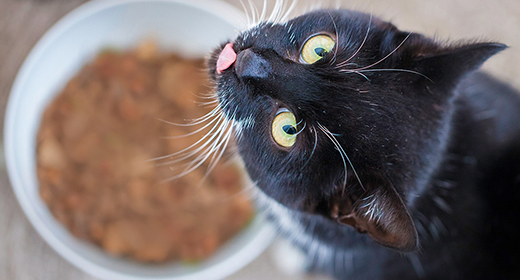

Do you know what’s in your cat’s food? And more importantly, do you know how those nutrients affect your cat’s health, including their muscles, skin, coat and nails, digestion, bone growth and so much more?
As the old adage goes, “You are what you eat,” so it stands to reason that by feeding your cat high-quality ingredients, their overall health will be positively impacted.
So, what’s in your cat’s food? Simply put, cat food nutrients are divided into four subcategories: protein, carbohydrates, fats, and vitamins and minerals. Learn more about each of these — and how they can affect your cat’s health.
Protein is best known for supplying amino acids, or protein subunits, to build hair, skin, nails, muscles, tendons, ligaments and cartilage.
Common cat food protein sources include meat, chicken, fish and some plant ingredients like corn gluten and soybean meal.
Cats and kittens are true carnivores and need essential amino acids. One of these, taurine, is not found in plant protein sources such as soybean meal — which means your cat needs a protein source from meat to stay healthy.
Carbohydrates (also known as starches [sugars]) and fibers provide energy and bulk, respectively. Plants and grains like wheat and corn are common carbohydrate sources.
Starches are made up of various types of sugar, such as glucose or fructose. Through digestion, cats can easily convert sugar into usable energy.
Fiber provides bulk to move food through your cat’s gastrointestinal tract, aiding in healthy digestion. Some types of fiber, such as vegetable gums and beet pulp, are fermented by bacteria in your cat’s intestines, creating short-chain fatty acids that serve as an important source of energy for the cells lining your cat’s intestinal tract.
Though it sometimes gets a bad rap, fat fulfills many vital bodily functions. Fat helps your cat maintain their body temperature, control inflammation and more. It is the primary form of stored energy in the body, providing twice as much energy as carbohydrates or proteins.
Fats are found in meats, fish and plant oils, such as flax and vegetable oils.
Fats also provide omega-6 and omega-3 fatty acids, which are important fat subunits. Omega-6 fatty acids are essential for skin and coat maintenance and proper membrane structure. Omega-3 fatty acids have also been shown to affect coat quality and skin health.
Nutrition tip: All IAMS™ dry foods contain an optimal ratio of omega-6 and omega-3 fatty acids to help support a healthy skin and coat.
Vitamins are responsible for promoting bone growth, blood clotting, energy production and oxidant protection in your cat.
Vitamins A, D, E and K require fat for absorption into the body, while vitamins such as the B-complex vitamins and vitamin C need water to be absorbed into the body.
Minerals provide skeletal support and aid in nerve transmission and muscle contractions.
Feeding your cat a high-quality, nutritionally complete diet is crucial. When choosing a cat food, make sure to read the label and look for optimal sources of protein, carbohydrates, fat, and vitamins and minerals. These building blocks will help ensure your cat lives a long and healthy life.


Fiber isn’t just for humans — it’s an important part of balanced nutrition for cats, too!
But how much fiber do cats need, what kinds should they be eating and how can you make sure they’re getting the right amount for their bodies?
Cats and humans both need fiber in their diets, but that doesn’t mean cats should be eating the same amount as humans. People are growing more aware of the importance of fiber in our own diets today — and while it’s good to think about your cat’s fiber intake too, it’s important to remember that cats have different dietary needs than humans.
Cats have a much shorter digestive tract than humans, and unlike humans, cats are carnivorous, so their nutritional needs are better satisfied with mostly animal-based ingredients rather than plant matter.
Nondigestible fiber supports cat health by providing bulk that helps move food through the digestive system. This fiber is largely made up of carbohydrates that cats can’t break down in the same way they digest protein or fat. This undigested matter helps usher food through your cat’s system at a healthy pace that lets them absorb the nutrients in their food and eliminate waste comfortably. Higher levels of nondigestible fiber can even help address specific conditions like frequent hairballs.
Fiber can’t be broken down and digested like proteins and fats, but some kinds can be fermented (broken down by bacteria) in your cat’s digestive system. This breakdown produces short-chain fatty acids, which provide energy to your cat’s intestines as it is fermented.
Fiber sources used in pet foods include cellulose, which is poorly fermentable; beet pulp, which is moderately fermentable; and gums and pectin, which can be highly fermentable. Appropriate levels of moderately fermentable fiber, such as beet pulp, provide the benefits of energy for the intestinal lining and bulk without the negative effects of excessive stool or gas. That makes them ideal for the health and comfort of most cats!
While a high-fiber diet can be part of a weight-loss solution for humans, our research has found that it’s not as helpful as a weight-reduction option for cats.
High levels of poorly fermentable fiber in cat food dilute the calories and nutrients in a serving and may make your cat feel fuller. Unfortunately, high fiber content can also increase the rate at which food passes through your cat’s digestive tract, making it harder for them to digest other nutrients in their food. They may be going to the litter box more often, but that doesn’t mean their digestive system is working more efficiently.
When choosing a pet food, remember that cats and humans need different things from their food. All IAMS™ cat food products are made with the right amount of moderately fermentable fiber needed to promote intestinal health. Use the IAMS™ Cat Food Selector to find a recipe tailored to your cat’s unique needs.